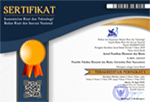Examining Entrepreneurial Success Factors of Women-Owned SMEs in Rattan Craft
DOI:
https://doi.org/10.33633/jpeb.v7i2.4731Abstract
The rattan craft industry is one of the most significant contributors to the economy, and women own this business. However, the success of the rattan craft SME is influenced by internal and external factors. This study aims to determine the effect of the personal aspects, environmental aspects, and government support on entrepreneurial success in rattan craft SME women. Data collection was carried out using a questionnaire. The sample used was 100 women SME owners of rattan craft. The sampling technique in this study is to use the accidental sampling technique. The analytical method used is multiple linear regression analysis (SPSS). The results showed that personal and environmental aspects, as well as support from the government, determine the success of rattan craft SMEs that belong to women entrepreneurs. The most considerable influence is from the personal aspect, in which family background and support play an essential role.References
Alstete, J. W. (2002). On Becoming an Entrepreneur: An Evolving Typology. International Journal of Entrepreneurial Behavior & Research, 8(4), 222–234. https://doi.org/10.1108/13552550210436521
Bose, T., & Uddin, M. R. (2013). Motivation, Success Factors and Challenges of Entrepreneurs in Khulna City of Bangladesh. European Journal of Business and Management, 5(16), 148–157. https://www.iiste.org/Journals/index.php/EJBM/article/view/6190
Brandstätter, H. (2011). Personality Aspects of Entrepreneurship: A Look at Five Meta-Analyses. Personality and Individual Differences, 51(3), 222–230. https://doi.org/10.1016/j.paid.2010.07.007
Brush, C. G., de Bruin, A., & Welter, F. (2009). A Gender?Aware Framework for Women’s Entrepreneurship. International Journal of Gender and Entrepreneurship, 1(1), 8–24. https://doi.org/10.1108/17566260910942318
Chell, E. (2008). The Entrepreneurial Personality: A Social Construction. The Entrepreneurial Personality: A Social Construction: Second Edition. Routledge. https://doi.org/10.4324/9780203938638
Dhaliwal, S. (2000). Entrepreneurship – A Learning Process: The Experiences of Asian Female Entrepreneurs and Women in Business. Education + Training, 42(8), 445–453. https://doi.org/10.1108/00400910010379970
Fielden, S. L., Davidson, M. J., Dawe, A. J., & Makin, P. J. (2003). Factors Inhibiting the Economic Growth of Female Owned Small Businesses in North West England. Journal of Small Business and Enterprise Development, 10(2), 152–166. https://doi.org/10.1108/14626000310473184
Grayy, K., & Collin, K. (2002). Innovation: A Cross-Disciplinary Perspective. Norwegian University Press.
Gupta, N., & Mirchandani, A. (2018). Investigating Entrepreneurial Success Factors of Women-Owned SMEs in UAE. Management Decision, 56(1), 219–232. https://doi.org/10.1108/MD-04-2017-0411
Haan, H. C. (2003). Fingers of One Hand’: Experiences of Small Businesses in the Northern Emirates. CLMRI.
Haan, H. C. (2004). Business Networking for SME Development in the UAE. CLMRI.
Jennings, J. E., & McDougald, M. S. (2007). Work-Family Interface Experiences and Coping Strategies: Implications for Entrepreneurship Research and Practice. The Academy of Management Review, 32(3), 747–760. https://doi.org/10.2307/20159332
Lidyana, V. (2019, August 31). Bangkit Dari Gempa Lombok, Wanita Ini Sukses Jualan Tas Rotan. DetikFinance. https://finance.detik.com/solusiukm/d-4687684/bangkit-dari-gempa-lombok-wanita-ini-sukses-jualan-tas-rotan
Masuo, D., Fong, G., Yanagida, J., & Cabal, C. (2001). Factors Associated with Business and Family Success: A Comparison of Single Manager and Dual Manager Family Business Households. Journal of Family and Economic Issues, 22(1), 55–73. https://doi.org/10.1023/A:1009492604067
Minniti, M., & Naudé, W. (2010). What Do We Know About the Patterns and Determinants of Female Entrepreneurship Across Countries? The European Journal of Development Research, 22(3), 277–293. https://doi.org/10.1057/ejdr.2010.17
Mitchelmore, S., & Rowley, J. (2013). Entrepreneurial Competencies of Women Entrepreneurs Pursuing Business Growth. Journal of Small Business and Enterprise Development, 20(1), 125–142. https://doi.org/10.1108/14626001311298448
Orhan, M., & Scott, D. (2001). Why Women Enter Into Entrepreneurship: An Explanatory Model. Women In Management Review, 16(5), 232–247. https://doi.org/10.1108/09649420110395719
Piperopoulos, P. (2012). Ethnic Female Business Owners: More Female or More Ethnic Entrepreneurs. Journal of Small Business and Enterprise Development, 19(2), 192–208. https://doi.org/10.1108/14626001211223856
Shepherd, D. A., Wiklund, J., & Haynie, J. M. (2009). Moving Forward: Balancing the Financial and Emotional Costs of Business Failure. Journal of Business
Venturing, 24(2), 134–148. https://doi.org/10.1016/j.jbusvent.2007.10.002
Sugiyono. (2019). Metode Penelitian Kuantitatif, Kualitatif, dan R&D. CV Alfabeta.
Suryana, Y., & Bayu, K. (2011). Kewirausahaan Pendekatan Karakteristik Wirausahawan Sukses (2nd ed.). Kencana Prenada Media Group.
Turmuzi. (2015, June 14). Kerajinan Ketak Desa Beleke Lombok Tengah Diekspor Sampai Ke Jepang. Cendana News. https://www.cendananews.com/2015/06/kerajinan-ketak-desa-beleke-lombok-tengah-diekspor-sampai-ke-jepang.html
Downloads
Published
How to Cite
Issue
Section
License
The copyright of the received article shall be assigned to the journal as the publisher of the journal. The intended copyright includes the right to publish the article in various forms (including reprints). The journal maintains the publishing rights to the published articles.
This work is licensed under a Creative Commons Attribution 4.0 International License.


.png)











